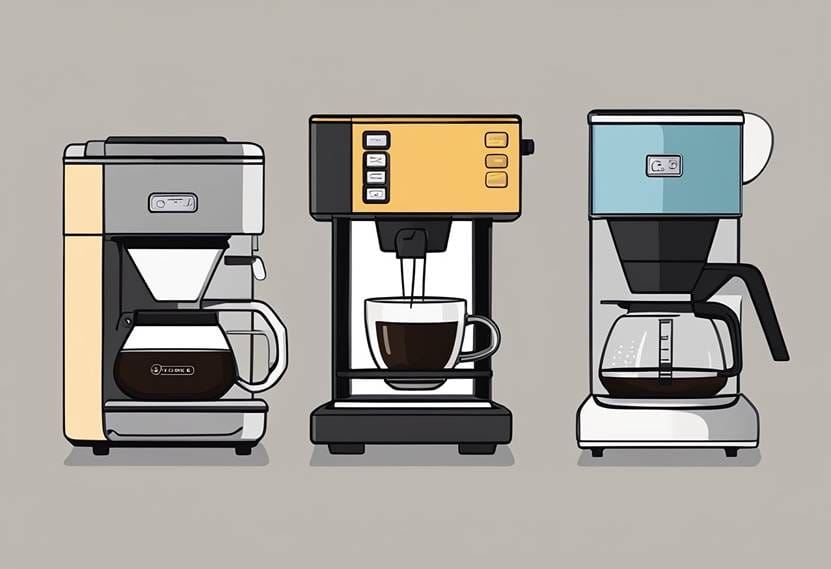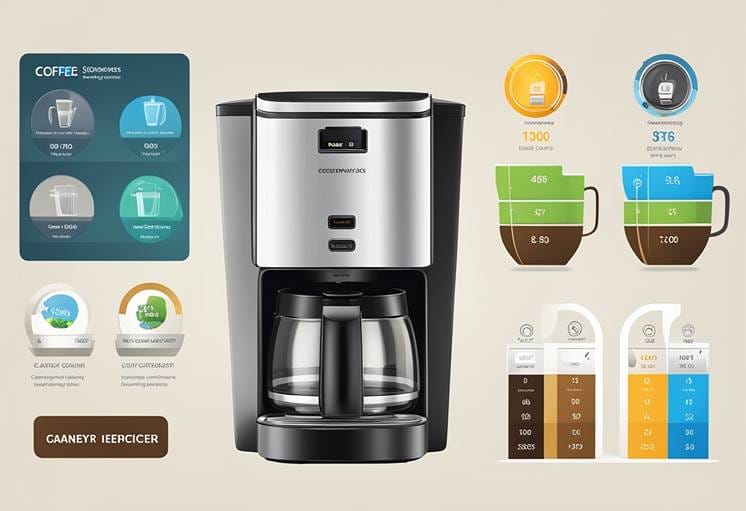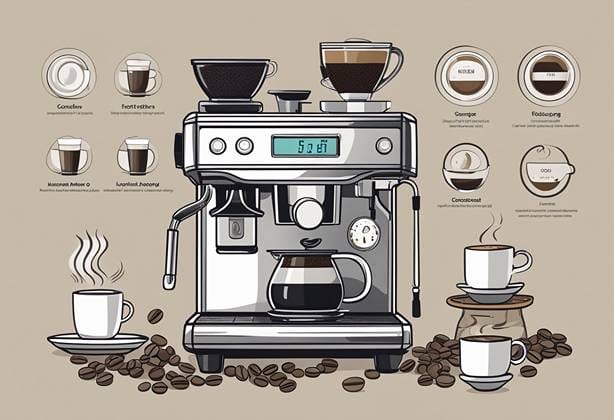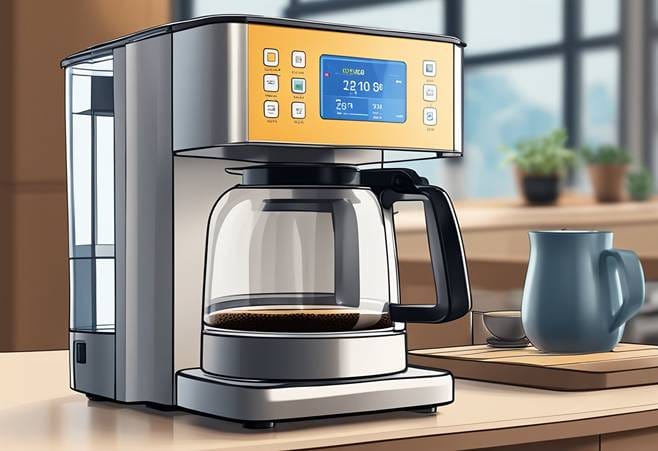Coffee maker wattage is an important factor to consider when selecting the perfect appliance to brew your favorite cup of coffee.
Understanding how much power a coffee maker consumes not only affects its energy efficiency and cost, but also impacts the brewing process and the features available in the machine.
From small drip coffee makers to elaborate espresso machines, the wattage varies across different types and sizes, influencing your daily caffeine consumption experience.

The wattage of a coffee maker typically ranges from 200 watts for simple models to over 1500 watts for advanced machines.
For instance, a small drip coffee maker may use 550 to 900w, while larger models consume 750 to 1200 watts in power.
Single-serve brewers, like Keurig or Nespresso machines, use 900 to 1500 watts, and automatic espresso machines consume between 1000 and 1500 watts.
As you navigate through the numerous options available in the market, it’s essential to weigh the wattage against factors like brewing speed, energy consumption, and the kind of coffee you enjoy to make an informed decision.
Key Takeaways
- Coffee maker wattage varies across different types and sizes, affecting the brewing process and energy efficiency.
- A typical wattage range for coffee makers is between 200 to 1500 watts, depending on the machine type and size.
- Higher wattage may indicate faster brewing times and increased power consumption, while lower wattage models may be more energy-efficient but slower to brew.
Understanding Coffee Maker Wattage

Definition and Importance of Wattage
Wattage refers to the rate at which electrical power is consumed by an appliance, measured in watts (W).
Understanding the wattage of a coffee maker is crucial because it directly affects your energy consumption and thus, your energy bills.
The higher the wattage, the more electrical power the machine uses, so choosing a coffee maker with an appropriate wattage can help you save on energy costs.
Average Coffee Maker Wattage
There is some variation in the wattage of coffee makers, but for reference, here are a few examples:
- Small drip coffee makers (4 or 5 cups): 550 to 900w
- Large drip coffee makers: 750 to 1200 watts
- Single-serve brewers (like Keurig or Nespresso): 900 to 1500 watts
- Automatic espresso machines: 1000 to 1500 watts
Remember to always check the specific wattage of your machine, as this can differ between models and manufacturers.
Wattage in Relation to Coffee Quality
While wattage contributes to the energy consumption of your coffee maker, it also plays a role in the quality of the coffee produced.
Higher wattage machines typically heat up water more quickly, providing optimal brewing temperatures that result in better extraction of coffee flavors.
But, wattage alone is not the only factor influencing coffee quality.
Other elements such as the brewing method, water temperature, and coffee grounds quality also come into play.
Therefore, when evaluating the performance of a coffee maker, it’s essential to consider these variables alongside its energy consumption.
Types of Coffee Makers and Their Wattages

Drip Coffee Makers
Drip coffee makers are a popular choice for many due to their simplicity and efficiency.
Their wattage typically ranges from 600 to 1,500 watts.
The wattage of a drip coffee maker depends on its size and capacity, with small 4-5 cup models consuming around 550 to 900 watts, while larger models can use 750 to 1,200 watts.
Single-Serve Coffee Makers
Single-serve coffee makers, such as Keurig and Nespresso machines, are designed to use pods or capsules for quick and convenient brewing.
These machines have a wattage range of 1,000 to 1,500 watts on average.
Due to their design, single-serve coffee makers may consume slightly more electricity than drip coffee makers, but they offer added convenience and variety.
Espresso Machines
Espresso machines are known for producing rich, concentrated coffee.
These machines typically use 1,000 to 1,500 watts of power.
Automatic espresso machines consume more electricity than manual ones due to their heating systems and additional functions, e.g., steaming milk for cappuccinos and lattes.
French Press and Other Non-Electric Coffee Makers
Non-electric coffee makers, such as French press and Moka pots, rely on manual methods to brew coffee.
Since they do not use electricity, they do not have wattage ratings. French press requires hot water to steep the coffee grounds, while Moka pots use a stovetop burner to heat water and force it through the coffee grounds.
Choosing one of these methods can help reduce your overall energy consumption and provide a more hands-on, customized coffee brewing experience.
Effects of Wattage on Brewing

Brewing Speed and Temperature
Higher wattage coffee makers usually excel at increasing brewing speed and maintaining optimal water temperature.
A higher wattage means more power, which leads to quick heating of the water and less time spent waiting for your coffee.
This is particularly useful when you need a fresh cup on a busy morning.
Furthermore, the brew temperature is a critical factor in the extraction process.
A consistent and optimal brewing temperature (between 195°F and 205°F) ensures a balanced extraction, resulting in a better flavor profile of your coffee.
Higher wattage machines have an advantage in maintaining the desired temperature throughout the brewing process.
Quality and Taste Extraction
The quality and taste of your coffee are heavily influenced by the brewing method and extraction.
Higher wattage devices provide a more consistent and efficient extraction, primarily due to their ability to maintain stable water temperature.
Different brewing methods require specific temperatures for optimal extraction. For example, an espresso machine demands a higher temperature than a French press for the best taste.
A higher wattage machine can adapt better to the temperature requirements of various brewing methods, resulting in better overall taste.
Another advantage of higher wattage coffee makers is that they allow for more customizable brewing options, giving you greater control over the coffee brewing process.
Adjusting these settings can help you achieve the desired strength and flavor profile for your coffee.
In summary, the wattage of a coffee maker impacts both the brewing speed and temperature, ultimately affecting the overall quality, taste, and extraction efficiency.
Understanding these effects assists you in choosing the right coffee maker that best suits your preferences and needs.
Energy Efficiency and Cost

Calculating Energy Usage
When it comes to the efficiency of your coffee maker, understanding its energy usage is important.
On average, coffee makers have a wattage of around 1,300W.
To calculate the energy consumption, you need to multiply the wattage by the usage time and divide it by 1,000 to get kilowatt-hours (kWh).
For instance, if you have a coffee maker with a wattage of 1,000W and you use it for 30 minutes, the energy usage would be:
(1,000W * 0.5 hours) ÷ 1,000 = 0.5 kWh
Impact on Electricity Bills
The cost impact on your electricity bill depends on the energy consumption of your coffee maker and the cost per kWh in your area.
To estimate the cost of running a coffee maker, multiply the energy consumption (kWh) by the electricity cost per kWh.
For example, if the energy consumption is 0.5 kWh and the electricity cost per kWh is $0.20:
0.5 kWh * $0.20 = $0.10
In this example, using your coffee maker for 30 minutes would cost 10 cents.
Keep in mind that these calculations are only estimates, as electricity rates vary depending on your location and provider.
Low-Wattage vs High-Wattage Cost Efficiency
There’s a variety of coffee makers with different wattages available on the market, from low-wattage basic models at around 500-900W to high-wattage single-serve brewers using 900 to 1,500W.
Comparing the cost efficiency of low-wattage and high-wattage coffee makers, let’s consider the following example:
- A low-wattage coffee maker (600W) used for 30 minutes:
(600W * 0.5 hours) ÷ 1,000 = 0.3 kWh - A high-wattage coffee maker (1,200W) used for 30 minutes:
(1,200W * 0.5 hours) ÷ 1,000 = 0.6 kWh
Assuming an electricity cost of $0.20 per kWh:
- Cost of using low-wattage coffee maker:
0.3 kWh * $0.20 = $0.06 - Cost of using high-wattage coffee maker:
0.6 kWh * $0.20 = $0.12
In this example, using a low-wattage coffee maker could save you 50% on your electric bill compared to a high-wattage model.
However, it’s also essential to consider other factors like brewing time, taste, and performance when choosing the right coffee maker for you.
Features and Options

Adjustable Wattage and Power Settings
Many coffee makers come with the ability to adjust their wattage and power settings.
This feature is particularly useful if you want to control how much electricity your coffee maker consumes.
By lowering the wattage, you can save on your energy bills without sacrificing the quality of your coffee.
For example, a small drip coffee maker typically uses 550 to 900 watts, while a larger model uses 750-1200 watts.
When considering an adjustable wattage coffee maker, it’s essential to know the range of power settings available.
Some models offer wider adjustments than others, allowing for greater flexibility in energy consumption.
Be sure to consult the coffee maker’s manual for information on its specific wattage range and how to adjust it.
Programmable Features and Keep Warm
Programmable features in coffee makers can help you maintain your desired coffee temperature and simplify your morning routine.
One popular option is the Keep Warm function, which ensures your coffee stays at a consistent temperature for an extended period after brewing.
This feature can save you time by eliminating the need to reheat your coffee when you’re not ready to drink it immediately.
Additionally, programmable coffee makers often include features such as timers and automatic shut-off.
Timers allow you to set your coffee maker to start brewing at a specific time, ensuring a fresh cup of coffee when you wake up or return home.
Automatic shut-off is a useful safety feature that turns off your coffee maker after a predetermined period, reducing the risk of potential accidents and conserving energy.
When choosing a coffee maker with programmable features, consider how these options align with your daily habits and preferences.
For example, if you frequently forget to turn off your coffee maker, an automatic shut-off feature would be a valuable addition.
As you evaluate potential coffee makers, pay attention to their power consumption, as additional features may require more electricity to operate.
In conclusion, adjustable wattage and power settings, as well as programmable features like “Keep Warm,” can enhance your coffee-making experience and help you save energy.
Making an informed decision about the right coffee maker for you will result in both a satisfying cup of coffee and more efficient energy usage.
Additional Considerations

Environmental Factors
When considering a coffee maker’s wattage, it’s important to look at the environmental impact.
Higher wattage coffee makers generally consume more energy, thus having a higher carbon footprint.
You might opt for a lower wattage home coffee maker, which can be more energy-efficient, helping you save on electricity bills and reduce your carbon footprint.
Keep in mind, though, that low wattage coffee makers may take longer to brew and might not reach optimal brewing temperatures consistently.
Safety and Voltage Requirements
As you evaluate different coffee makers, it’s essential to consider their safety and voltage requirements.
Coffee makers can have varying wattages, anywhere from 550 to 1500 watts, and this can affect the safety and performance of your machine.
Ensure that your home or office is equipped to handle the voltage and amperage of the coffee maker you plan to purchase.
Most countries use 110-240 volts as their standard voltage.
Keep these factors in mind to avoid electrical issues and potential hazards.
Remember, a higher-wattage coffee maker might provide better performance and maintain optimal brewing temperatures, but it will consume more energy.
On the other hand, a lower-wattage machine could be more eco-friendly and energy-efficient but might not provide the same speed and temperature consistency.
Make an informed decision based on your priorities and ensure that your electrical setup meets the voltage requirements of your chosen coffee maker.
Conclusion
Understanding the wattage of your coffee maker is crucial for any coffee lover looking to make coffee efficiently while managing energy consumption.
The wattage of coffee makers can vary widely, with common coffee maker models using anywhere from 550 to 1500 watts of power.
This range highlights the diversity in the design and functionality of machines, from simple drip coffee makers that consume less power to advanced coffee makers and espresso coffee machines that use up to 1500 watts for brewing and to keep the coffee hot.
For those considering the cost of running your coffee maker, it’s important to know that a typical coffee maker requires significant power to heat water quickly.
However, once the coffee is made, less energy is needed to keep the coffee warm.
Therefore, energy-efficient coffee makers are designed to use the least amount of electricity necessary to maintain the warmth of your coffee without compromising on the quality of the brew.
The amount of electricity a coffee maker uses can significantly impact your utility bills, especially if you make coffee daily.
For example, using a drip coffee maker that operates at 1000 watts for one hour equals 1 kWh of electricity usage.
This usage, while seeming small on a day-to-day basis, can add up over time.
Therefore, opting for models that are energy efficient or use less power, such as those operating between 200-400 watts of power, can be a more cost-effective and environmentally friendly choice.
For off-grid coffee brewing, especially during emergency power outages or for those utilizing solar power, knowing the wattage of your coffee maker allows for better planning.
A small coffee maker with 400 watts can be easily powered by a standard power station or a solar generator, ensuring you can enjoy fresh coffee without access to the main power grid.
In conclusion, when selecting a coffee maker, considering the wattage is key for those looking to balance the love for coffee with energy consumption and cost.
Whether you’re using coffee pods, ground coffee, or making espresso, choosing a machine that aligns with your power station’s capacity, especially if you’re reliant on solar power or concerned about energy use, can significantly enhance your coffee experience while being mindful of electricity use.
Frequently Asked Questions

How many watts does a coffee maker use on average?
On average, coffee makers use between 550 and 1500 watts of power to brew a pot of coffee.
The exact amount of power a coffee maker uses depends on its brand, model, and the functionalities it offers.
Do pod coffee makers use a lot of electricity compared to drip coffee makers?
Pod coffee makers, such as single-serve coffee machines, typically use less electricity, ranging from 900 to 1500 watts per use.
In comparison, traditional drip coffee makers consume between 550 and 1200 watts.
This means pod coffee makers can be slightly more energy-intensive per cup but are generally used for shorter periods.
Are there any energy-efficient coffee makers available?
Yes, numerous models of coffee makers are designed to be energy efficient.
These coffee makers often have features like automatic shut-off, programmable timers, and low-wattage heating elements that help reduce energy consumption.
Brands market these models as energy-efficient options for those looking to save on electricity without sacrificing the quality of their coffee.
Can I use a solar generator to power my coffee maker?
Yes, you can use a solar generator to power your coffee maker, especially if the generator can handle the average wattage requirements of a coffee maker, which is between 550 and 1500 watts.
Make sure to check the generator’s output capacity to ensure it can efficiently power the coffee maker.
How much power does it take to make coffee without a traditional coffee maker?
Making coffee without a traditional coffee maker, such as using a French press or pour-over method, requires heating water using another appliance, like a kettle.
Electric kettles typically use between 1200 and 3000 watts, but since their usage time is short, they don’t use a lot electricity.
These alternative methods can be quite efficient in terms of energy consumption.
What is the cost of running your coffee maker every day?
The cost of running one coffee maker depends on the amount of power it uses (ever wondered how many watts power up your coffee maker – between 550-1500 watts of electricity on average), how long it runs, and your local electricity rates.
Assuming a coffee maker uses 1000 watts and runs for 15 minutes daily, with an electricity rate of $0.12 per kWh, the daily cost would be about $0.03, and annually around $10.95.
Can running a coffee maker use a lot of electricity if left on all day?
Yes, leaving a coffee maker on all day can significantly increase its energy consumption.
Many coffee makers maintain the coffee temperature by keeping the warming plate active, which continues to draw power.
It’s recommended to turn off the coffee maker or use models with automatic shut-off features to save on electricity, this way you’ll have energy efficient coffee makers.
How do different types of coffee makers compare in terms of energy consumption?
Different types of coffee makers have varying levels of energy consumption.
Single-serve pod coffee makers and espresso machines typically use more energy per cup due to the high temperatures and pressure needed.
Drip coffee makers and French press coffee makers are generally more energy-efficient since they either use less electricity or none at all for the French press.

